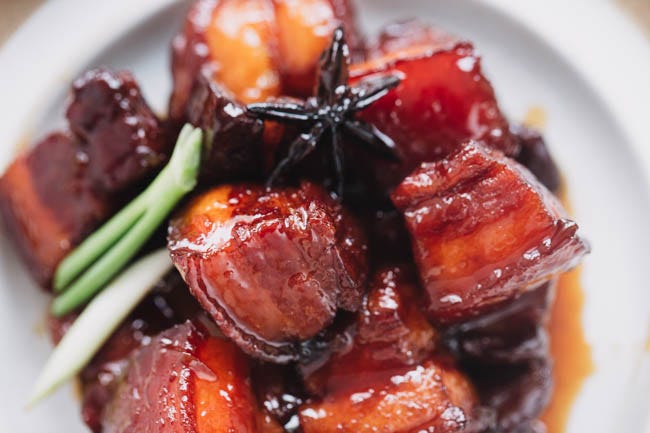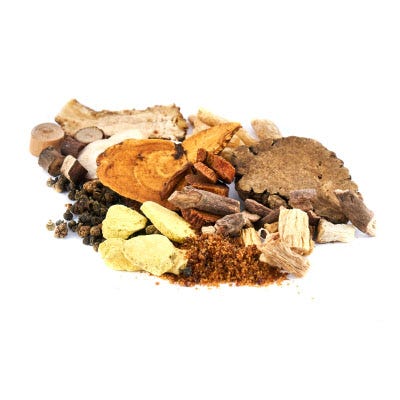While I don’t aim to get too technical in these pages, I thought it might be interesting for non-specialist readers to get a glimpse into how classical Chinese herbal medicine works. Expect posts on classical formulas like this one to crop up now and again. -JHE
One of the things I love about the formula featured in today’s post, Wen Jing Tang, is that it’s herbal equivalent of the Chinese dish red-cooked pork belly (braised bacon, essentially)1. I also love that in Chinese medicine, such a dish (and formula) is understood to be healthy. Not for everyone all the time, certainly, but for some people some of the time. Such a far cry from the neurotic-about-fat (and neurotic-due-to-lack-of-good-fat) American mindset.
Wen Jing Tang translates as “Decoction to warm the channels” (sometimes translated “warm the menses”). It’s a famous women’s health and beauty formula that is, however, “not just for the ladies” as my teacher Brandt Stickley once said. What do I mean by “beauty formula?” That’ll become clear in a moment, once we understand the formula’s gestalt, or what we call its “presentation.”
A presentation is akin to a syndrome, a constellation of signs and symptoms; a pattern.
As I’ve described recently, classical Chinese medicine formulations work not by treating the disease alone, nor by treating the person alone, but by treating something in between. This something is the presentation. It’s the way a disease manifests in a person.
So, what is the presentation for this formula?
The patient—classically female—is rather chilly and dry. Their complaint may be infertility, menstrual pain, fatigue, low libido, thinning hair, brain fog or any number of other issues. Their complexion tends pale or ashen, with a tender-looking, pale or dusky-purple tongue (never a dry, red tongue or a thickly-coated one). Their pulse is likely to be on the thin side. Abdominal palpation may reveal a comparatively narrow sterno-costal angle and a thin abdominal wall, with or without much tension in the rectus abdominis muscle, and pulsations along the midline. The skin may feel dry and/or cool to the touch.
What this patient is missing is a certain hormonal juiciness. They’re blood-deficient, if by “blood” we understand not only the red fluid in our vessels, but a general quality of tissue plumpness. These patients, in other words, are rather undernourished. They’re also chilly. And yet, due to the relative lack of yin and blood, they may have localized heat signs: thirst, night sweats, or hot palms and feet.
But the telltale sign is the lips. If I’m already considering Wen Jing Tang and then discover that the patient has dry lips, either visibly or reportedly, then the finding seals the deal. I can sit back and watch as from week to week they regain a glow and sparkle. The relief is something akin to a dry sponge expanding and relaxing as it finally soaks up some moisture.
Now we’re in a position to understand how this combination of herbs can function as a beauty formula: by restoring tissue plumpness, skin moisture, and something less tangible that the Chinese call “peach luck” and that we can gloss as hormonal magnetism.
Besides helping people to look and feel their best, my favorite part of prescribing Wen Jing Tang is that I get to tell the patient to go and eat plenty of pork belly, braised lamb shanks, and other fatty, collagen-rich foods. Genuinely, truly, for their health.
Although this is something of an '“off-label” use, Wen Jing Tang is also of great potential utility in cases of early-stage cognitive decline such as Alzheimer’s. Of course, the presentation has to be right. A warm, obese patient with oily skin should never take this formula (but may do quite well with something like Chaihu jia Longgu Muli Tang). A thin, dry, pale, chilly patient with memory issues will probably do wonderfully.
Wen Jing Tang
Dosages are given in grams per day as a decoction and may vary. Wen Jing Tang may also be given in granular extract form or cooked into a concentrated gao (syrup) with honey and/or molasses.
Guizhi / Cinnamon Twig 6
Danggui / Angelica sinensis root 6
Chuanxiong / Ligusticum root 4
Baishao / Peony root 6
Wuzhuyu / Evodia fruit 3
Maimendong / Ophiopogon tuber* 10
Ejiao / donkey hide gelatin** 8
Banxia / Pinellia rhizome 6
Dangshen / Codonopsis root*** 8
Shengjiang / fresh ginger 6
Mudanpi / Tree peony root bark 4
Zhigancao / stir-baked licorice root 4
*I’ll often use Tianmendong (Asparagus root, known in Ayurveda as Shatāvari) in addition
** I’ll typically omit ejiao (an animal product )due to ethical considerations or will substitute a dense, sticky tonic plant material like Huangjing or Dihuang.
*** Originally renshen, ginseng root
Potential modifications are many, and perhaps too technical to get into (but do leave a comment if you’d to see more shop talk here). Suffice to say there are a number of directions this formula can be taken in order to deal with various concurrent conditions such as fluid metabolism issues, insomnia, Raynaud’s, etc. As long as the basic gestalt, the dry-thin-chilly presentation is there, it’ll likely serve as an excellent starting point.
This idea comes from Dr. Huang Huang, whose ideas about Wen Jing Tang I discovered first in his book Ten Key Formula Famlies in Chinese Medicine, and then in elaborated form in Sharon Weizenbaum’s article “Wen Jing Tang According to Huang Huang.” The article even gives a recipe for Chinese red-cooked pork belly: delicious.





This is fascinating, Jonathan. Thank you.
hi! curious if something like this can be safely given/ or modified for someone who is about 27 weeks pregnant? I run very cold and have iron challenges, being mostly plant based and I’d love some guidance there. my mother has the same challenges with paleness/ chilliness/ being thinner etc.